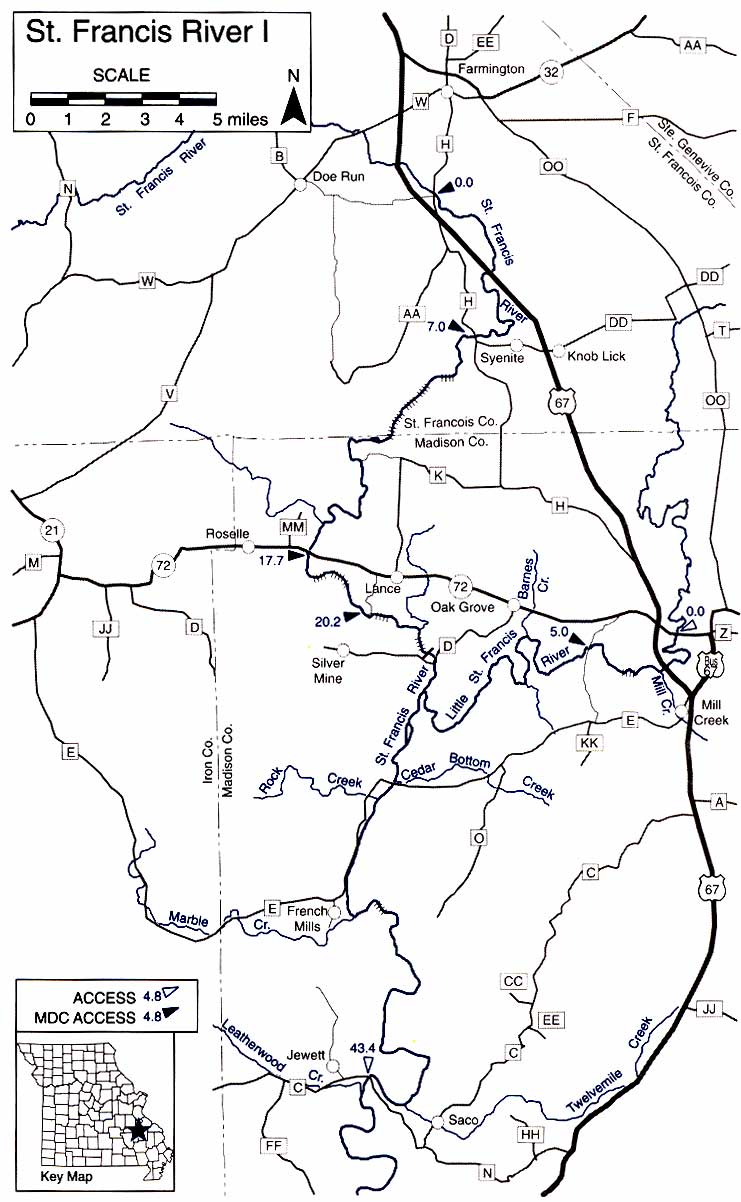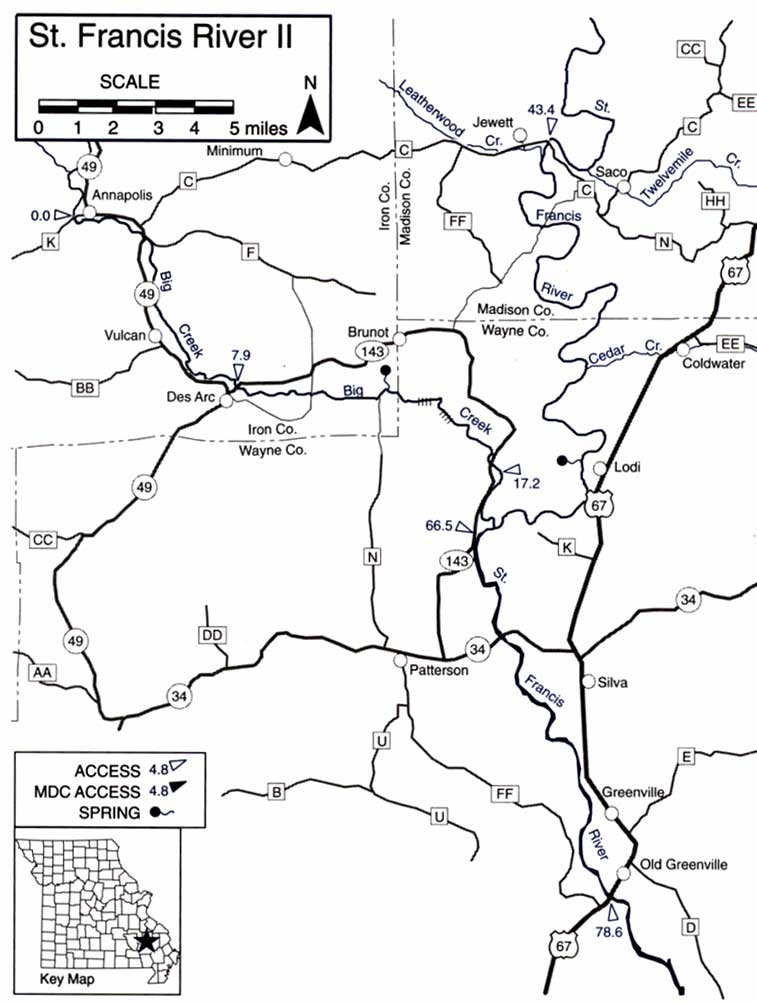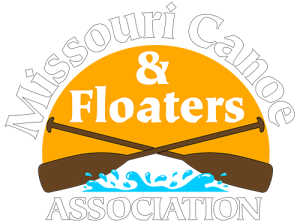St. Francis River and Big Creek
Missouri’s St. Francis River
In sharp contrast to the more western Ozark streams, the upper St. Francis cannot be called a “float” stream. It presents a challenge to the experienced canoeist. Due to its boulderstrewn course, it can be run only during high or moderately high water; that is, in spring or after rather heavy rains. Both the St. Francis and its tributary, Big Creek, run a straighter course than float streams, through narrow defiles of resistant granitic Rock called shut-ins. Big Creek is floatable only in spring or early summer. The rougher sections of these streams are clearly indicated in the descriptions below. Due to their relatively hazardous nature, these sections provide some of the wildest scenic river runs in the state. For shut-ins sections, it is advisable to carry only lunch and other small items in the canoe and to take life jackets and enough rope to line canoes through bad places if deemed necessary. In high water, decked canoes would be advisable.
Difficulty: I to III in most runable stages. Some sections IV, in high water, to possible V in flood.
Gradients: general- 6.1; Hwy. H, 3 miles south of Farmingron, to Hwy. 72 – 8.2; to Silvermine (Hwy. D) – 20; 10 Hwy. C-N – 5.7; to Sam A. Baker State Park – 3.8; to Hwy. 67 – 2.8.
Counties: St. Francois, Madison, Wayne.
Missouri’s Big Creek
This St. Francis River tributary is only floatable in spring and early summer. The Big Creek Shut-ins are one of the main features of Sam A. Baker State Park and are worth seeing by boat when there is sufficient water.
Difficulty: I to 111 in most runable srages. Some sections IV, in high water, to possible V in flood.
Gradients: general – 11.8
Counties: Wayne, Iron.


St. Francis River – Mile-By-Mile Description
St. Francis River I
0.0 Gruner Ford Access. Hwy. H Bridge 3 miles sourh of Farmingron. River has a normal float gradient. Must carry boats a short distance to river.
3.0 Hwy. 67 Bridge.
7.0 Syenite Access on right, just downstream of Hwy. H Bridge. Gravel ramp.
8.2 River begins to flow more rapidly. Next 3 miles has gradient of 20 feet per mile. Several long pools end in rocky, steep drops. Vision is often obscured by dense willow thickets. Use caution! This can be a dangerous section in high water.
13.2 Spur from Hwy. K meets river. No access.
16.7 Wachita Creek enters on right. Granite bluffs with pines on each side of river.
17.7 Roselle Access on right at Hwy. 72 Bridge. Gravel/dirt ramp. Cafe and store nearby. Begin shut-ins sections. This section should nor be run by inexperienced canoeists. In high water it should be run by experts only. Difficulty ratings of the rapids range from III in moderately low water to V in flood stage. Fast riffle below the access leads to slow section but rapids soon begin. Low bluff on the right and sound of the water warn of first rapids, which begins with a rocky ledge across the river. The next 1.5 miles includes three sharp drops. Quiet sections invariably end in rapids.
store nearby. Begin shut-ins sections. This section should nor be run by inexperienced canoeists. In high water it should be run by experts only. Difficulty ratings of the rapids range from III in moderately low water to V in flood stage. Fast riffle below the access leads 10 slow section but rapids soon begin. Low bluff on the right and sound of the water warn of first rapids, which begins with a rocky ledge across the river. The next 1.5 miles includes three sharp drops. Quiet sections invariably end in rapids.store nearby. Begin shut-ins sections. This section should nor be run by inexperienced canoeists. In high water it should be run by experts only. Difficulty ratings of the rapids range from III in moderately low water to V in flood stage. Fast riffle below the access leads 10 slow section but rapids soon begin. Low bluff on the right and sound of the water warn of first rapids, which begins with a rocky ledge across the river. The next 1.5 miles includes three sharp drops. Quiet sections invariably end in rapids.
20.2 Millstream Gardens Conservation Area and access on left. Must carry boat down steep slope to gravel ramp.
20.8 Begin mile of continuous rapids with sharp drops. Scouting on foot is essential. A picnic shelter on left bank overlooks beginning of this rapids section. The steepest drop on the river is just below this. It is 4-6 feet, depending on water stage, but the chute has a difficult S-curve approach.
22.3 Turkey Creek enters on left. Rocky rapids continue to damsite.
22.7 Silver Mine Dam. Breech blown in left side of dan1 is mnable, but in high water produces a high wave at the bottom which would swamp an open canoe. A “rockgarden” run from here to the bridge.
23.2 Hwy. D Bridge and Silver Mines Recreation Area and campgrounds. There are campsites on both sides of the river below the bridge and on the left side above the bridge.
24.7 Little St. Francis enters on left.
27.5 Hwy. E Bridge. Cedar Bottom Creek on left.
28.2 Rock Creek on right.
29.6 Begin passage berween Marlow Mountain, on left, and Black Mountain. There are some fast runs both above and below this area, but the passage berween the rwo mountains is mostly a long pool with Hwy. E along right bank.
31.4 French Mills and Little Rock Creek on right. Half a mile up this creek there is a pretty shut-ins area, about a half mile in length, with a drop of 80 feet. It can be reached on foot via Hwy. E., which parallels it.
32.0 Marble Creek on right has shut-ins 2 miles upstream.
32.8 Begin passage berween rwo high hills. At lower end of this run, granite ourcroppings constrict the river, producing a rapids with rwo drops. Waves are somctimes high enough to pur a considerable amount of water imo a loaded, open canoe. May be scoured easily from rock ledge on left.
34.8 Wade Ford. Closed to public access.
36.2 Unusual cave in bluffs. 37.6 Marsh Creek on right.
41.9 Marsh Ford.
42.1 T welvemile Creek on left. Sertlement of Sacois is 1 mile up the creek.
43.4 Hwy. C-N Bridge at Jewett. High bank but can be used as an access.
St. Francis River II
43.4 Hwy. C-N Bridge at Jewett. High bank but can be used as an access.
43.7 Leatherwood Creek on right.
47.4 Shelron Ford at junction of county roads 445 and 447.
51.2 Reed Bend Ford. Cannot drive to river here.
52.1 Five small caves in bluff on right.
53.5 Bald Knob on left.
55.5 Head Ford. Reached from Coldwater on County Road 302. 56.9 Cedar Creek on left.
61.9 Spring on right. Settlement of Lodi on left.
62.4 Kelly Ford. No access.
65.2 Spur of Mudlick Mountain on right. Logan Mountain on left. 66.1 Big Creek enters on right.
66.5 Sam A. Baker State Patk access and campgrounds. Water becomes slower below this point.
69.8 Hwy. 34 Bridge. Access.
71.2 Clark Creek on right.
73.4 Hubble Creek on left.
75.4 Hwy. 67 runs near left bank.
76.4 Lake Creek on right. Access and campground.
78.6 Hwy. 67 Bridge. Last access before Lake Wappapello. Greenville Recreation Area on right. Parking lor on left just below bridge. Dam is 18 miles across the lake.
Big Creek – Mile-By-Mile Description
0.0 Hwy. K.
2.2 Hwy. 49 Bridge. Section to Des Arc is fast but has some shallow pools. This part is a high-water float only. A railroad parallels the creek to Vulcan.
7.9 Hwy. 143 Bridge. Good access.
10.1 Paved ford. Portage.
11.1 Shut-ins between two hills.
12.2 The Battery, a group of cottages at the site of an old bridge, 2 miles south of Brunot. Spring just above bridge.
12.9 Big Creek Shut-ins begin. Run is beautiful and not ordinarily dangerous. A couple of rapids require caution.
13.9 Crane Pond Creek on left.
15.9 Shut-ins open up.
17.2 Low-warer bridge in Sam A. Baker State Park. Portage. Good access bur there are a couple of fur runs below this access and other accesses downstream in the park.
19.2 Junction with St. Francis River.
This is an electronic reprint of a Missouri Department of Conservation document. More or updated information on this topic can be found at the Missouri Department of Conservation web site located at: mdc.mo.gov. Copyright 2003 by the Conservation Commission of the State of Missouri.
Go to MCFA Home Page
